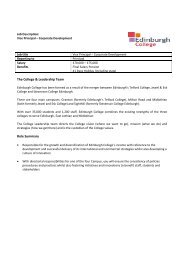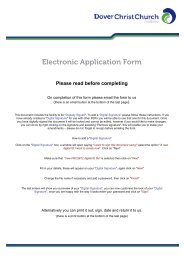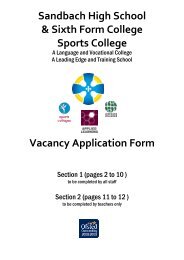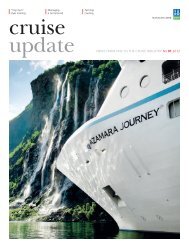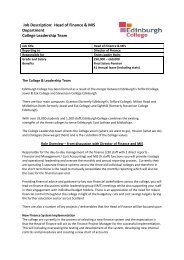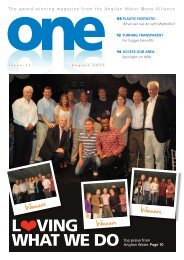update NewS from dNv to the tANker INduStry No 02 2011 - Hays
update NewS from dNv to the tANker INduStry No 02 2011 - Hays
update NewS from dNv to the tANker INduStry No 02 2011 - Hays
You also want an ePaper? Increase the reach of your titles
YUMPU automatically turns print PDFs into web optimized ePapers that Google loves.
CO2 emissions <strong>from</strong> shipsShip type Capacity a cEEDI reference lineslarger tankersBulk carrier dwt 961.79 0.47710Gas tanker dwt 1120.00 0.456Tanker dwt 1218.80 0.488Container 70% – dwt 174.22 0.201General cargo dwt 107.48 0.216Reefer dwt 227.01 0.244EEDI (g CO2/<strong>to</strong>nne-nm)EEDI (g CO2/<strong>to</strong>nne-nm)98765432140353<strong>02</strong>5201510500 10000 20000 30000 40000 50000050000 15000<strong>02</strong>50000 350000 450000Combination dwt 1218.80 0.488›› Table 2DwtDwtTanker and combinationGas tankerTanker and combinationGas tanker›› Figure 1 EEDI reference lines based on average for tankers built during last ten years.›› Tore Longva, Business Development ManagerInternational Affairs.wan Attained EEDI and those that musthave an Attained EEDI below a certainRequired EEDI. Ship types needing <strong>to</strong>comply with a specific Required EEDI level<strong>to</strong> obtain <strong>the</strong> IEEC are listed in Table 1,which also indicates <strong>the</strong> time line for <strong>the</strong>tightening of <strong>the</strong> requirement levels.A ship’s reference line value is calculatedbased on <strong>the</strong> following formula:a · Capacity –cwhere <strong>the</strong> a and c parameters are given inTable 2 above.Pho<strong>to</strong>: DNVA ship which can load 100% deadweightwith both liquid and dry cargo is considered<strong>to</strong> be a combination carrier and canuse <strong>the</strong> same reference line as tankers. Gastankers have a separate reference line. Thereference lines for tanker and combinationcarriers as well as for gas tankers areshown in Figure 1. The lines s<strong>to</strong>p at <strong>the</strong>lower cut off lines for <strong>the</strong> ship types, belowwhich <strong>the</strong> required EEDI does not apply.In order <strong>to</strong> address concerns raisedby developing countries, <strong>the</strong> regulationsinclude a clause allowing any Administration<strong>to</strong> waive <strong>the</strong> EEDI requirements forships flying its flag for a period of up <strong>to</strong>four years (linked <strong>to</strong> <strong>the</strong> contract date),or six years and six months (linked <strong>to</strong> <strong>the</strong>delivery date) after 1 January 2013. However,<strong>the</strong> preliminary indications are that<strong>the</strong> major flag states will be reluctant <strong>to</strong>invoke <strong>the</strong> waiver clause.Ship Energy Efficiency ManagementPlan (SEEMP) <strong>No</strong> changes weremade <strong>to</strong> <strong>the</strong> SEEMP at MEPC 62, butits inclusion in <strong>the</strong> MARPOL Annex VIamendments makes it manda<strong>to</strong>ry forall ships– both new and existing – afterit enters in<strong>to</strong> force. The presence of aSEEMP onboard will be checked during<strong>the</strong> first intermediate or renewal surveyfor <strong>the</strong> IAPP certificate, at which point <strong>the</strong>IEEC will be issued. The EEDI will not becalculated for existing vessels and thus notincluded in <strong>the</strong> IEEC.Future CO2 regulations The adoptionof <strong>the</strong> amendments is a significantstep by IMO <strong>to</strong>wards <strong>the</strong> regulation ofGHG emissions. Never<strong>the</strong>less, <strong>the</strong> EU islikely <strong>to</strong> consider it insufficient in ligh<strong>to</strong>f its own ambitions. The EU processfor establishing a regional CO2 emissionreduction mechanism for shipping is<strong>the</strong>refore expected <strong>to</strong> continue.O<strong>the</strong>r parts of <strong>the</strong> international communityalso consider <strong>the</strong>se regulationsinsufficient. There is <strong>the</strong>refore a strongpolitical drive <strong>to</strong> regulate shipping fur<strong>the</strong>r,e.g. through regional or international MarketBased Measures (MBMs). Proposalsunder review range <strong>from</strong> a contribution orlevy on CO2 emissions <strong>from</strong> shipping, viaemission trading systems <strong>to</strong> schemes basedon ship efficiency. If agreed, MBMs mayappear <strong>to</strong>wards <strong>the</strong> end of this decade.Commercial energy efficiency requirementsare becoming increasingly important.The creation of various voluntaryschemes for rating environmental performance,including CO2 performance, isproviding <strong>to</strong>ols that allow charterers andcargo owners <strong>to</strong> use only ships that satisfy<strong>the</strong>ir environmental requirements. Theserating schemes must be based on robustmethods and verifiable data in order <strong>to</strong>Tanker <strong>update</strong> NO. 2 <strong>2011</strong> | 5




